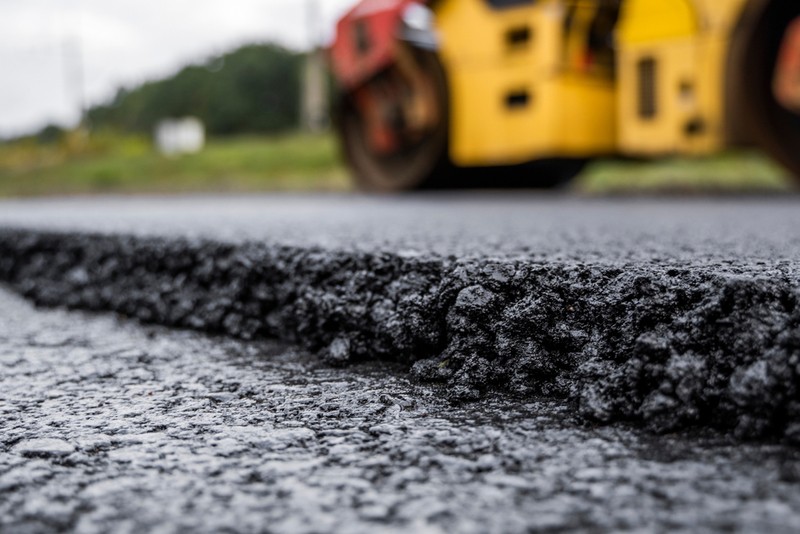Release the Prospective: Regrading and Asphalt Sealing for Industrial Areas
Wiki Article
Warm Mix Asphalt: A Lasting Service for Pavement
Warm Mix Asphalt (HMA) has actually arised as a leading lasting choice for pavement remedies, using a myriad of ingenious modern technologies and ecological advantages. As the demand for environment-friendly building and construction methods expands, discovering the nuances of HMA's sustainability can provide valuable understandings right into the future of sidewalk remedies.Ecological Advantages of Warm Mix Asphalt

Moreover, Warm Mix Asphalt aids to mitigate metropolitan warm island impacts. Its dark shade soaks up sunlight, minimizing the amount of warm showed back into the environment contrasted to lighter-colored pavements. This can reduce ambient temperature levels in city areas, decreasing the need for a/c and eventually minimizing energy usage.
In enhancement, Hot Mix Asphalt contributes to improved stormwater monitoring. Its porous nature enables water to penetrate the pavement and charge groundwater supplies, decreasing runoff and the danger of flooding. These ecological benefits make Hot Mix Asphalt a sustainable choice for paving highways and roadways.
Power Efficiency in HMA Production
Is energy performance an essential element in the manufacturing of Hot Mix Asphalt (HMA)? Power plays a considerable duty in the manufacturing of HMA, affecting both price and ecological sustainability. One crucial element of power effectiveness in HMA manufacturing is the use of cozy mix asphalt (WMA) modern technologies.Moreover, improvements in plant innovations have actually caused more energy-efficient HMA manufacturing procedures. Modern plants are developed with attributes like recycled asphalt sidewalk (RAP) processing capabilities, efficient heater systems, and improved insulation, all adding to energy savings. By enhancing energy usage in HMA manufacturing, the market can minimize its carbon footprint while keeping high-grade sidewalk products. Energy performance is, therefore, an essential factor to consider in making certain the sustainability of Warm Mix Asphalt production.
Recyclability of Warm Mix Asphalt
The recyclability of Warm Mix Asphalt (HMA) is a crucial aspect of its sustainability and lasting ecological effect. HMA is just one of the most recycled products in the USA, with over 100 million lots of reclaimed asphalt pavement (RAP) being reused annually in new pavement building. Reusing HMA supplies several environmental benefits, such as minimizing the need for virgin products, reducing energy usage during production, and lowering the quantity of waste sent to landfills.The process of recycling HMA includes milling the existing sidewalk, crushing it into smaller items, and mixing it with brand-new accumulation and asphalt binder to create a recycled mix. This recycled mix can Recommended Reading typically do as well as or perhaps better than traditional HMA, while needing less raw materials and producing reduced greenhouse gas discharges. By including RAP into new pavement tasks, road companies can conserve natural deposits, reduce expenses, and lessen the ecological impact of roadway construction and maintenance activities. Generally, the recyclability of HMA plays a substantial role in advertising lasting methods within the sidewalk sector.

Long-Term Efficiency of HMA
Asphalt pavements show durability and resilience over a prolonged period, showing the long-lasting efficiency of Warm Mix Asphalt (HMA) The long life of HMA can be attributed to its ability to withstand rush hour loads, severe climate condition, and the effects of aging. Researches have actually revealed that properly designed and correctly constructed HMA sidewalks can last for twenty years or more with regular upkeep. The secret to maximizing the long-lasting efficiency of HMA exists in utilizing premium products, following ideal techniques in building and construction, and carrying out efficient maintenance approaches. Appropriate drainage, regular inspections, and timely repair work are essential for maintaining the structural honesty of HMA sidewalks with time. Additionally, developments in HMA technology, such as the usage of polymer-modified binders and warm mix asphalt, have additionally boosted the longevity and longevity of HMA pavements. By prioritizing top quality construction and upkeep techniques, HMA remains to prove itself as a cost-efficient and lasting option for long-lasting pavement infrastructure.
HMA: Toughness and Sustainability
Demonstrating both durability and sustainability, Warm click Mix Asphalt (HMA) has come to be a foundation in the construction of long-lasting pavement facilities - hot mix asphalt. HMA's Read Full Report sturdiness stems from its capacity to endure heavy tons, rough weather condition problems, and high traffic quantities, making it a reputable selection for streets, highways, and airport paths. The composition of HMA, which commonly includes aggregates, binder, and filler, plays a critical function in improving its longevity and resistance to tear and put on
In addition, HMA's sustainability exists in its recyclability and energy-efficient manufacturing process. The capability to reuse reclaimed asphalt pavement (RAP) in brand-new HMA mixes decreases the demand for virgin products and reduces the environmental impact of sidewalk building and upkeep. Furthermore, the energy efficiency of creating HMA hinges on its reduced blending temperatures compared to various other pavement materials, causing lowered power intake and greenhouse gas discharges.
Verdict
In final thought, warm mix asphalt (HMA) provides a sustainable service for sidewalk with its eco pleasant characteristics. HMA's recyclability, power efficiency in production, and long-lasting toughness make it an eco-friendly choice for road construction.
HMA is one of the most recycled products in the United States, with over 100 million bunches of reclaimed asphalt pavement (RAP) being reused yearly in new pavement building.The procedure of recycling HMA involves grating the existing pavement, crushing it into smaller sized pieces, and blending it with brand-new aggregate and asphalt binder to produce a recycled mix.Asphalt sidewalks demonstrate resilience and strength over an extensive duration, showing the long-lasting performance of Hot Mix Asphalt (HMA) Additionally, improvements in HMA technology, such as the usage of polymer-modified binders and warm mix asphalt, have actually further improved the longevity and long life of HMA pavements. The capability to recycle reclaimed asphalt sidewalk (RAP) in new HMA combinations decreases the demand for virgin materials and reduces the environmental effect of sidewalk building and construction and upkeep.
Report this wiki page